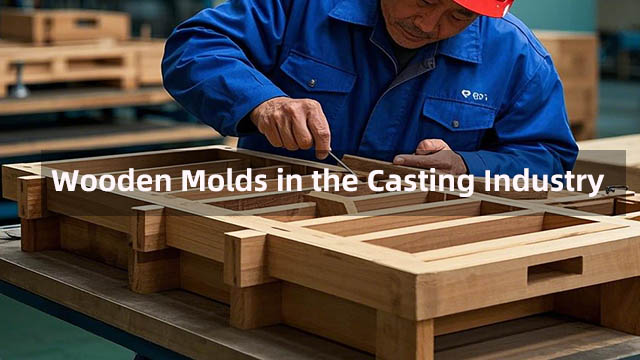Wooden Molds in the Casting Industry
2025-01-24 11:07:28 hits:0
Throughout the long - standing development of the casting industry, wooden molds have always occupied a significant position. From the simple hand - made castings in the early days to the casting of precision and complex industrial parts today, wooden molds, as a fundamental and crucial mold material, have provided indispensable support for the implementation of casting processes.

Definition and Basic Concepts of Wooden Molds
As the name implies, a wooden mold is a mold made from wood as the raw material. It is a model shaped to correspond to the shape and size of the casting through a series of processing procedures according to the design requirements of the casting. During the casting process, the wooden mold is used to form the cavity of the mold. After the liquid metal is poured into the cavity and cooled and solidified, a casting with the same shape as the wooden mold is obtained. A wooden mold is not just a simple model; it carries the design information of the casting. It is the first step in casting production, and its quality and accuracy directly affect the quality of the subsequent castings.
Manufacturing Process of Wooden Molds
The production of wooden molds is a job that combines skills and experience. First, suitable wood needs to be selected according to the design drawings of the casting. Commonly used woods include Korean pine, white pine, basswood, etc. These woods have characteristics such as uniform texture, straight grain, and easy processing. After the material selection is completed, craftsmen will use a variety of tools and processes such as sawing, planing, milling, chiseling, and carving to process the wood. For example, a saw is used to cut the wood into a rough shape, then a plane is used to flatten the surface, and precise dimensional processing is carried out through a milling machine. For some complex shapes and details, the carving process is used to complete them. During the production process, craftsmen need to operate strictly according to the design dimensions to ensure the accuracy of the wooden mold. After the preliminary processing is completed, surface treatments such as sanding and painting are also carried out on the wooden mold to improve the surface quality of the wooden mold and prevent the wood from getting damp and deforming.
Performance Characteristics of Wooden Molds
- High Processing Flexibility: Wood is easy to process, and wooden molds of various shapes and sizes can be made according to different casting design requirements. Whether it is a simple geometric shape or a complex irregular structure, it can be realized through the skillful hands of craftsmen. This gives wooden molds great advantages in meeting diverse casting needs.
- Relatively Low Cost: Compared with other mold materials such as metal molds, the cost of wood is relatively low. Moreover, the manufacturing process of wooden molds is relatively simple and does not require expensive equipment and complex process flows, which further reduces the production cost. For the casting of small - batch production and single - piece production, using wooden molds can effectively control costs.
- Lightweight: Wooden molds are lightweight and convenient for handling and operation. When placing the wooden mold in a sand box for molding during the casting process, it will not bring too much burden to workers due to excessive weight, and it is also conducive to improving production efficiency.
- Limited Service Life: Due to the low hardness of wood, it is easily worn during repeated use, resulting in a decrease in the accuracy of the mold. Moreover, wood has strong hygroscopicity, and changes in environmental humidity may cause the wooden mold to deform, thus affecting the dimensional accuracy of the casting. Therefore, the service life of wooden molds is relatively short, and regular maintenance and replacement are required.
Application Scenarios of Wooden Molds
- Small - Batch Production: When casting small - batch products, using wooden molds is an economical and practical choice. Because the order quantity of small - batch production is small, if metal molds with higher costs are used, the cost of the mold allocated to each casting may be too high. The low - cost advantage of wooden molds can just make up for this problem, which can not only meet the production needs but also control costs.
- Single - Piece Custom Production: For some customers who need to customize special castings, wooden molds have great advantages. Since the design of each customized casting may be different, the processing flexibility of wooden molds can quickly respond to design changes and make molds that meet the needs of customers according to their requirements, providing convenience for single - piece custom production.
- Art Casting Field: In the art casting field, wooden molds play an irreplaceable role. Art castings often have unique shapes and exquisite details, and the molds need to accurately restore the creativity of artists. The easy - to - process and plastic nature of wooden molds enables craftsmen to make various exquisite molds according to the designs of artists through processes such as carving, providing the possibility for art casting.
Development Trends of Wooden Molds
With the continuous development of casting technology, wooden molds are also constantly being improved and innovated. On the one hand, the emergence of new types of wood and wood treatment technologies helps to improve the performance of wooden molds. For example, the moisture - proof and wear - resistant properties of specially treated wood have been significantly improved, thus extending the service life of wooden molds. On the other hand, digital technologies are being increasingly applied in the production of wooden molds. Through computer - aided design (CAD) and computer - aided manufacturing (CAM) technologies, wooden molds can be designed and produced more accurately, improving the accuracy and production efficiency of wooden molds. At the same time, 3D printing technology has also brought new ideas to the production of wooden molds. It can quickly produce wooden molds with complex shapes, further expanding the application scope of wooden molds.
As a traditional yet vibrant mold material in the casting industry, wooden molds play an important role in casting production with their unique performance characteristics and wide application scenarios. Although they have some limitations, with the continuous progress of technology, wooden molds are constantly adapting to new demands and continuously contributing to the development of the casting industry.

 en
en  fra
fra  de
de  ru
ru  gle
gle  th
th  ara
ara  it
it  jp
jp  kor
kor  zh
zh 


